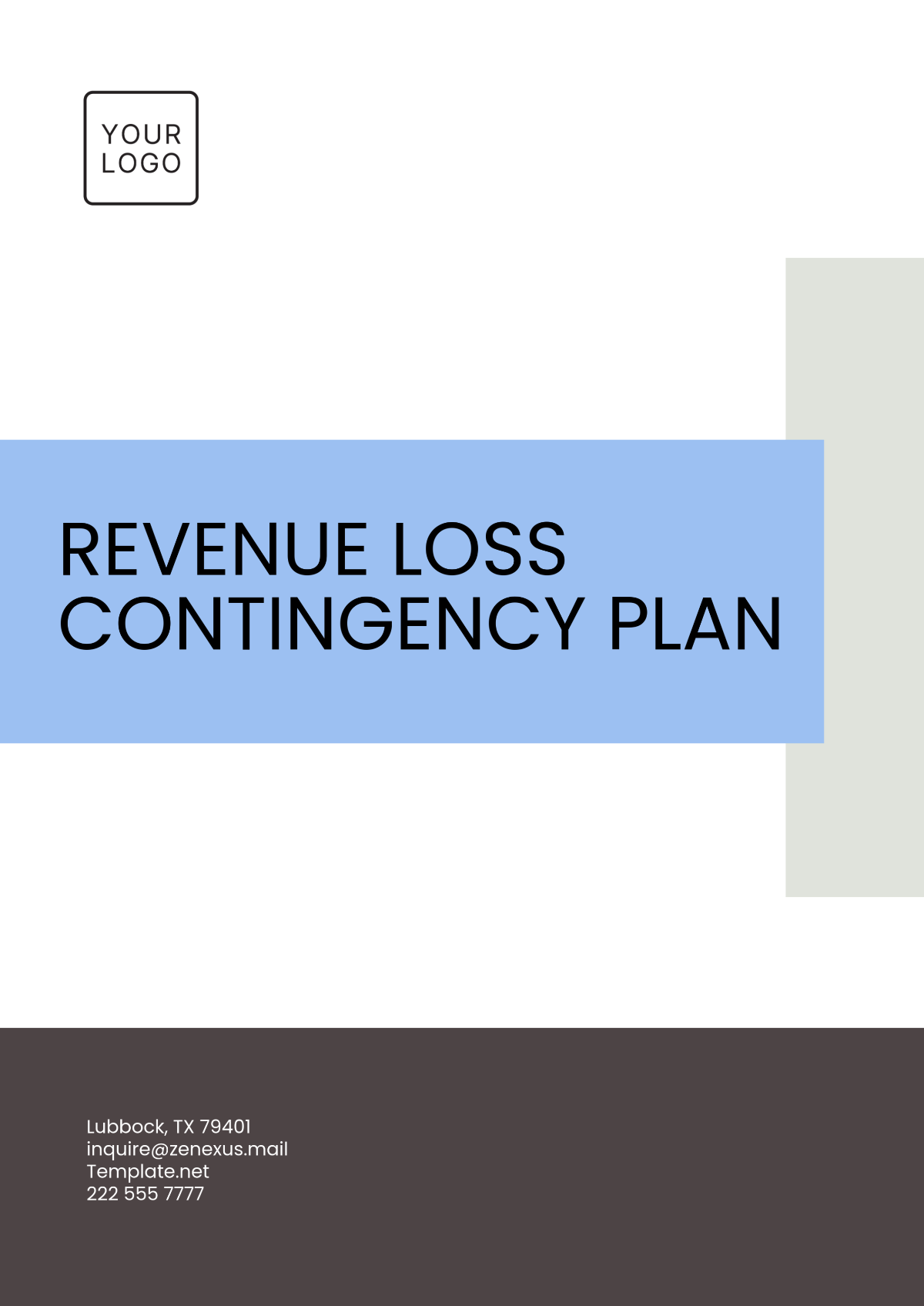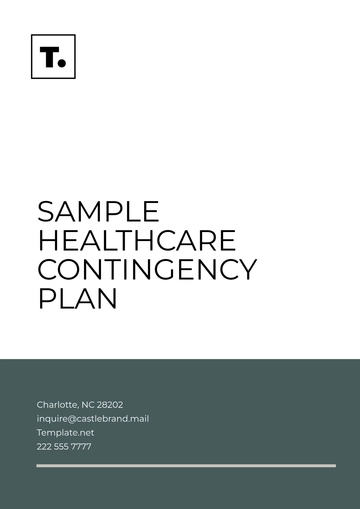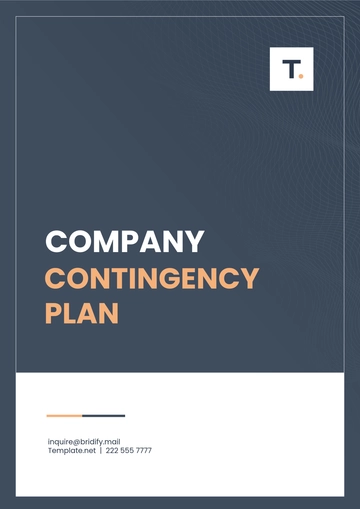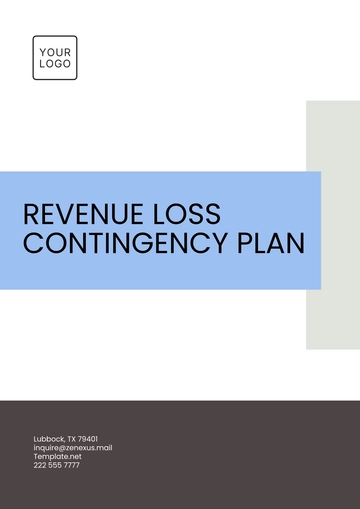Free Revenue Loss Contingency Plan

Prepared By: [Your Name]
Date: January 8, 2060
I. Executive Summary
The Revenue Loss Contingency Plan is designed to address possible interruptions to the organization's income in advance, aiming to recognize hazards, devise countermeasures, set up recovery procedures, assess financial consequences, and guarantee effective communication, with the main aim of safeguarding the company's financial health and sustaining seamless operations through detailed risk management.
II. Risk Identification and Analysis
In this section, we identify and analyze potential sources of revenue loss. The analysis includes:
Economic Downturn: Assessing how macroeconomic factors such as recession or inflation can reduce consumer spending.
Regulatory Changes: Conduct a thorough analysis to understand the potential effects of the recently introduced legislation on our various sources of revenue.
Market Competition: Identifying emerging competitors and shifts in market dynamics that threaten market share.
Supply Chain Disruptions: Analyzing potential vulnerabilities in the supply network that could affect product delivery.
Technological Failures: Understanding risks related to system outages and data breaches.
III. Mitigation Strategies
To minimize the likelihood or severity of revenue loss, the following strategies are proposed:
Developing a flexible pricing model to adapt to competitive and economic changes.
Investing in continuous market research to anticipate shifts in consumer behavior.
Increasing supply chain resilience through diversification and strategic partnerships.
Enhancing regulatory compliance systems to quickly adapt to new laws.
Implementing robust cybersecurity measures to safeguard company data and operations.
IV. Recovery Actions
The following procedures outline our approach to recovering lost revenue efficiently:
Implementing targeted marketing campaigns to regain customer loyalty and attract new customers.
The company is considering increasing the variety of its products or services available to access new opportunities for generating additional income streams.
Engaging in the process of renegotiating contracts with suppliers to obtain more favorable terms and pricing arrangements.
The process involves a comprehensive examination and consideration of various alternative financial models, which encompasses the formation or establishment of strategic partnerships or alliances.
V. Financial Impact Assessment
An in-depth financial analysis is conducted to understand the revenue loss impacts. This includes:
Calculating potential financial losses under various scenarios.
Assessing the cost-effectiveness of proposed mitigation measures.
Forecasting the financial impact timelines to prioritize actions.
VI. Communication Plan
A structured approach to communication ensures clarity and transparency both internally and externally:
Internal Communication: Regular updates are provided to management and staff through the use of the company's intranet system and by organizing town hall meetings.
External Communication: To maintain confidence, we must engage stakeholders, clients, and the media with timely press releases and newsletters, fostering positive relationships and trust through transparent messaging.
VII. Monitoring and Review
Continuous monitoring and periodic reviews are crucial for the plan's effectiveness:
Create a team to regularly assess risks and update plans.
Utilizing data analytics to track revenue patterns and identify anomalies.
Conducting bi-annual reviews with key stakeholders to refine the strategies.
This Revenue Loss Contingency Plan is designed to remain dynamic and adaptive to ensure preparedness and resilience against potential revenue challenges well into the 2060s and beyond.
- 100% Customizable, free editor
- Access 1 Million+ Templates, photo’s & graphics
- Download or share as a template
- Click and replace photos, graphics, text, backgrounds
- Resize, crop, AI write & more
- Access advanced editor
Mitigate revenue loss risks with the Revenue Loss Contingency Plan Template from Template.net. This editable and customizable template helps businesses create a plan to address unforeseen financial setbacks, including market downturns or unexpected expenses. Editable in our Ai Editor Tool, it ensures your plan is tailored to your specific financial circumstances. Secure your company’s financial stability—download and personalize this template today!
You may also like
- Finance Plan
- Construction Plan
- Sales Plan
- Development Plan
- Career Plan
- Budget Plan
- HR Plan
- Education Plan
- Transition Plan
- Work Plan
- Training Plan
- Communication Plan
- Operation Plan
- Health And Safety Plan
- Strategy Plan
- Professional Development Plan
- Advertising Plan
- Risk Management Plan
- Restaurant Plan
- School Plan
- Nursing Home Patient Care Plan
- Nursing Care Plan
- Plan Event
- Startup Plan
- Social Media Plan
- Staffing Plan
- Annual Plan
- Content Plan
- Payment Plan
- Implementation Plan
- Hotel Plan
- Workout Plan
- Accounting Plan
- Campaign Plan
- Essay Plan
- 30 60 90 Day Plan
- Research Plan
- Recruitment Plan
- 90 Day Plan
- Quarterly Plan
- Emergency Plan
- 5 Year Plan
- Gym Plan
- Personal Plan
- IT and Software Plan
- Treatment Plan
- Real Estate Plan
- Law Firm Plan
- Healthcare Plan
- Improvement Plan
- Media Plan
- 5 Year Business Plan
- Learning Plan
- Marketing Campaign Plan
- Travel Agency Plan
- Cleaning Services Plan
- Interior Design Plan
- Performance Plan
- PR Plan
- Birth Plan
- Life Plan
- SEO Plan
- Disaster Recovery Plan
- Continuity Plan
- Launch Plan
- Legal Plan
- Behavior Plan
- Performance Improvement Plan
- Salon Plan
- Security Plan
- Security Management Plan
- Employee Development Plan
- Quality Plan
- Service Improvement Plan
- Growth Plan
- Incident Response Plan
- Basketball Plan
- Emergency Action Plan
- Product Launch Plan
- Spa Plan
- Employee Training Plan
- Data Analysis Plan
- Employee Action Plan
- Territory Plan
- Audit Plan
- Classroom Plan
- Activity Plan
- Parenting Plan
- Care Plan
- Project Execution Plan
- Exercise Plan
- Internship Plan
- Software Development Plan
- Continuous Improvement Plan
- Leave Plan
- 90 Day Sales Plan
- Advertising Agency Plan
- Employee Transition Plan
- Smart Action Plan
- Workplace Safety Plan
- Behavior Change Plan
- Contingency Plan
- Continuity of Operations Plan
- Health Plan
- Quality Control Plan
- Self Plan
- Sports Development Plan
- Change Management Plan
- Ecommerce Plan
- Personal Financial Plan
- Process Improvement Plan
- 30-60-90 Day Sales Plan
- Crisis Management Plan
- Engagement Plan
- Execution Plan
- Pandemic Plan
- Quality Assurance Plan
- Service Continuity Plan
- Agile Project Plan
- Fundraising Plan
- Job Transition Plan
- Asset Maintenance Plan
- Maintenance Plan
- Software Test Plan
- Staff Training and Development Plan
- 3 Year Plan
- Brand Activation Plan
- Release Plan
- Resource Plan
- Risk Mitigation Plan
- Teacher Plan
- 30 60 90 Day Plan for New Manager
- Food Safety Plan
- Food Truck Plan
- Hiring Plan
- Quality Management Plan
- Wellness Plan
- Behavior Intervention Plan
- Bonus Plan
- Investment Plan
- Maternity Leave Plan
- Pandemic Response Plan
- Succession Planning
- Coaching Plan
- Configuration Management Plan
- Remote Work Plan
- Self Care Plan
- Teaching Plan
- 100-Day Plan
- HACCP Plan
- Student Plan
- Sustainability Plan
- 30 60 90 Day Plan for Interview
- Access Plan
- Site Specific Safety Plan





























